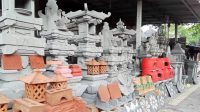- CREMATION or Ngaben is ritual procession of the Hindus to release the soul from the bondage of its physical body to further resume its afterlife journey. Having completed the procession, the soul is considered sacred and ready to reincarnate
In Bali, cremation is an essential and deeply ingrained cultural tradition. Balinese Hindus believe in reincarnation, and they consider cremation as a vital part of the cycle of life and death, paving the way for the soul to be reincarnated into a new form. The cremation ceremony is known as “Ngaben.”
A series of processions must be carried out. However, the procession will highly depend on the category of the ritual organized. In general, here are some key aspects of the cremation tradition in Bali:
Timing
In Bali, the timing of cremations can vary, depending on the family’s financial and social status. Wealthier families might be able to afford more elaborate ceremonies, which could delay the cremation for some time. In contrast, less affluent families might conduct simpler ceremonies and cremations sooner after the person’s passing.
Mass Cremations
Due to the expenses and logistics involved in organizing cremation ceremonies, mass cremations are quite common in Bali. This means that several bodies are buried first and then cremated together, and families often wait until they have accumulated enough resources to perform such ceremonies. On the cremation, a small amount of soil at cemetery is taken where the deceased was buried as symbol . Another tradition may optionally takes up the bones of the deceased to be cremated in the ngaben procession.
Preparation and Rituals
Prior to the actual cremation, there are several rituals and ceremonies conducted by the family and the local community. These rituals may include prayers, offerings, purification ceremonies, and processions to prepare the deceased for their journey to the afterlife.
Cremation Procession
The actual cremation day is a significant event with a grand procession. The body is placed in a coffin or a special sarcophagus, often shaped like a bull or other animal. The sarcophagus is then carried to the cremation ground on a tall, ornate bamboo tower called “bade” or “wadah.” The procession is accompanied by traditional Balinese music and the mourners dressed in customary attire.
Cremation Ground
The cremation ground is typically located near the Dalem Temple. It is a sacred space where the cremation ceremony takes place. The sarcophagus is placed inside a high tower-like structure called “bade.” Having arrived at cemetery, the body is downloaded and then put inside the sarcophagus in the form animal and the like.
Unless using animal-like sarcophagus, the body will be put in a zinc or iron platform to be further cremated. The tower itself after being used is then set ablaze.
After the cremation, the ashes and remaining bones are collected and placed in a nearby river or the sea, symbolizing the final release of the soul from its earthly ties.
Celebration of Life
Balinese cremation ceremonies are not only about mourning but also celebrating the life of the deceased. They are vibrant and colorful events, as Balinese Hindus believe that death should not be viewed as a sorrowful event, but rather as a continuation of life’s cycle.
They believe that the soul is released from the bondage of physical form, and after the cremation procession the soul begins its journey to the afterlife and has passed through ritual purification.
After the procession ends, the ancestral soul will be taken to worship at temple of his griya (house to his brahmin priest), trinity village at local village’s temple, clan temple and his family’s temple, finally enthroned in the three-chambered shrine.
The Ngaben cremation ceremony is a unique and deeply spiritual tradition that reflects the Balinese people’s strong cultural and religious beliefs. It is also an essential social event that brings the community together to support the bereaved family and honor the departed soul. After which, the soul is believed to be ready to reincarnate.











